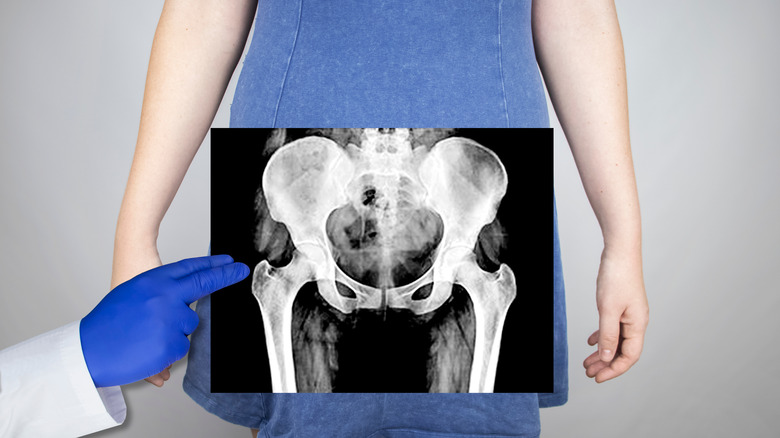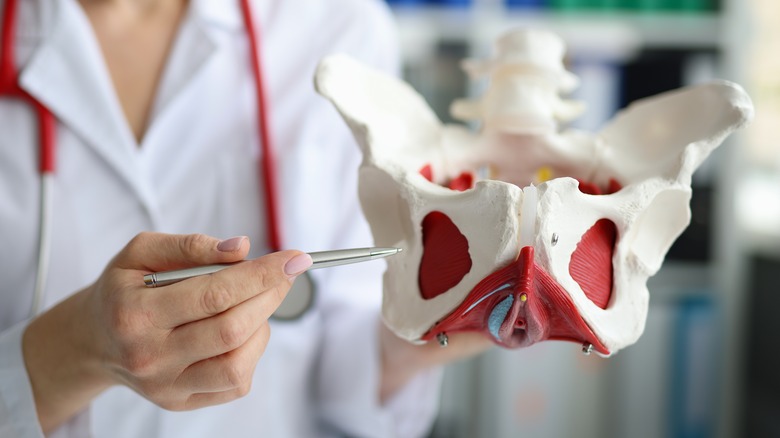Everything You Need To Know About The 4 Main Pelvis Types For Women
Physiopedia states that the pelvis includes five bony structures called the sacrum (the bone at the base of the spine), the coccyx (tailbone), the ischium (lower part of the hip bone), the ilium (the upper part of the hip bone), and the pubis (the bone at the front of the pelvis just below the abdomen).
The purpose of the pelvis, according to the Encyclopedia Britannica, is to support the torso as well as connect it to the legs. It also protects and supports the intestines, the urinary bladder, and the reproductive organs.
Healthline explains that there are some differences between male and female pelvises. Generally, a woman has a wider, broader pelvis than a man. Radiopedia further explains that a woman's pelvis has a round pelvic inlet compared to a man's narrower oval or heart-shaped one. Additionally, the angle of a woman's public arch is more than 90 degrees while a man's is less.
The purpose of these variations is so that when a baby is born it can move through the birth canal more easily.
4 main types of female pelvises
The Geneva Foundation for Medical Education and Research clarifies that there are four types of pelvises that women might have, although they note that most pelvises are actually a mix of these types.
About half of women will have a gynecoid pelvis. It has a wide, open shape. They describe this as the "normal" type since it is the most common.
Around a quarter of women will have an anthropoid pelvis. According to Healthline, this type of pelvis is deep and narrow and it is somewhat like an upright egg in its shape and orientation.
An additional 20% will have an android pelvis. This type of pelvis is narrower and has a triangular or heart-shaped opening.
Finally, about 5% of women will have a platypelloid pelvis. This type is wide but flat. Its shape and orientation are similar to an egg lying on its side.
What are the implications of pelvis type for childbirth?
Healthline explains that the shape of a woman's pelvis might give us some insight into how difficult it will be for her to give birth.
Gynecoid is considered the most favorable type of pelvis for childbirth due to its wide, open shape. It is believed to offer plenty of room for a baby to pass through.
Android is thought to be a more difficult shape for childbirth because it is more narrow. This can cause the baby to move more slowly through the birth canal, sometimes necessitating a C-section.
Compared to the android pelvis, anthropoid pelvises offer more space from front to back because of their elongated shape. However, they are still narrower than a gynecoid pelvis. Women with this pelvis type may be able to have a vaginal birth, but may have a longer labor.
Women with platypelloid pelvises might also require a C-section since this pelvis type can create difficulty in passing through the pelvic inlet due to its flatter shape.
Does your pelvis type doom you to a C-section?
Given that pelvis type seems to influence how easily you can expect to give birth, you might be concerned about whether you will have to have a C-section.
Karen Carola, a midwife from New Jersey who spoke with Modern Fertility, suggests that having a particular shape of pelvis does not mean that you can't have a vaginal birth. "All pelvis types can allow for spontaneous vaginal birth," says Carola.
Carola further explains that there is more involved in giving birth besides the pelvic bones. "Ligaments and joints come into play, as well as the mother's attitude toward birth, the size of the baby, and the position of the baby," she says.
The pelvic bones aren't totally irrelevant though, according to Carola. The do affect how the baby must rotate and descend through the pelvis.
The bottom line? Carola recommends not worrying too much about the shape of your pelvis. Your healthcare provider will be able to guide the birth process just fine.
How to know which type of pelvis that you have
According to Medscape, there are two ways for a doctor to know what type of pelvis you have: by doing clinical pelvimetry or by doing radiographic pelvimetry. Generally, radiographic pelvimetry is done with an MRI or CT scan.
Pelvimetry involves measuring the pelvis and the size of the baby's head relative to the pelvis, says Family Practice Notebook. However, they note that this is not recommended or routinely done in the United States since it is considered to be a poor predictor of whether a woman will be able to deliver her baby vaginally.
According to a Cochrane Collaboration review, there is not enough evidence to show whether pelvimetry is beneficial or safe. They found that women who had X-ray pelvimetry done were more likely to have a C-section, but there was not enough good evidence showing that it actually improved outcomes.
When you might need a C-section
Verywell Family explains that a C-section may become necessary if your baby is very large or is in a difficult position for delivery, such as the breech position. If your pelvis is too small, this can also present a problem. They say, however, that it is very rare that there is a true mismatch between the baby's size and the size of your pelvis. The pelvis is very flexible and the baby's head is also able to change its shape so it can fit through the birth canal.
Having a pelvis that is too narrow can happen, but it is difficult to determine this prior to giving birth. For this reason, it will usually only be diagnosed during labor when it is taking longer than expected or things are not progressing as they should. If your doctor determines that it will not be safe for you to continue with a vaginal delivery, she may choose to deliver your baby via C-section.






